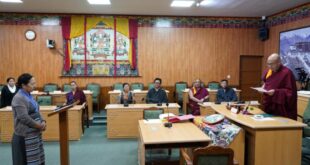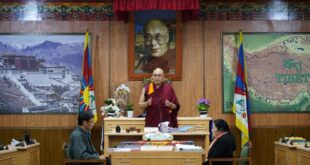Tibet is the world’s highest and largest plateau.’ Photograph: Purbu Zhaxi/Xinhua Press/Corbis
Dr. Lobsang Sangay, published on The Guardian, November 12 2015
The roof of the world. That is what Tibet has long been known as. The phrase conjures up images of summits, with their mountain peaks, glaciers, permafrost and the nomads who live on the land. But a roof is also symbolic of a home, and is the structure that protects those who live there. And, as we all know, if the roof is structurally compromised, then so is the home.
Tibet’s glaciers are melting, and the world needs to notice. Its permafrost is degrading, and the world needs to care. Tibet is suffering from massive deforestation and damming projects, and the world needs to act.
Why now? Because as world leaders gather in Paris this December for the United Nations COP 21 meetings on climate change, Tibet needs to be on the climate change agenda.
It is an environmentally strategic area and its importance to the sustainability of the world’s fragile ecosystem cannot be overstated. At an average elevation of 4,000 metres above sea level, and with an area of 2.5m sq km, Tibet is the world’s highest and largest plateau.But, in addition to being the “roof of the world”, here are a few other equally suitable epithets.
The third pole: the Tibetan plateau has 46,000 glaciers, making it home to the third largest concentration of ice after the south and north poles.
The water tower of Asia: the Tibetan plateau is the head source of Asia’s six largest rivers. These waters are a critical resource to the more than 1.3 billion people in the world’s 10 most densely populated nations surrounding the plateau.
The rain-maker: the Tibetan plateau influences the timing and intensity of monsoons in the region.
And as world leaders sit in their climate-controlled rooms in Paris, they need only think back to this summer and the massive heatwave that affected most of Europe to see yet another example of the critical role Tibet plays in global weather systems. Those heatwaves have been linked to thinning snow cover on the Tibetan plateau. The plateau’s temperature has increased by 1.3C (34.4F) – three times the global average.
Glaciers on the Tibetan plateau are melting at a rate of 7% annually and if the current rate continues, two-thirds of the glaciers on the plateau will be gone by 2050.
The Alpine permafrost, critical for the health of the planet, is at serious risk. On the Tibetan plateau, the permafrost stores more than 12m tonnes of carbon. But 10% of this permafrost has degraded in the past decade. With the permafrost degradation and the resulting release of carbon, the impact on climate change will be, needless to say, devastating.
A global environmental catastrophe can be avoided, but we must act now to ensure that the Tibetan plateau is protected. In the lead-up to COP 21, the Central Tibetan Administration is calling on world leaders to take urgent action on climate change, starting with a strong global climate agreement in Paris. Such an agreement needs to have meaningful and transparent commitments from all governments, including China.
China recently committed to cap carbon emission by 2030. Although a welcome announcement, this commitment must not be realised by further damaging Tibet’s environment. China’s proposed expansion of hydropower dams is not the solution.
China has already dammed every major river in Tibet. And more damming is expected. In China’s 12th five-year plan hydropower projects are a stated priority.
Without proper consultation and impact assessments, these hydropower projects can cause serious, irreversible environmental damage. China should also become a signatory to the United Nations water convention, committing to protect the quantity and quality water resources.
The United Nations must act by recognising the significance of the Tibetan plateau. A comprehensive understanding of global climate change is impossible without looking at Tibet. UN-led research studies are needed to better understand the impact of climate change on the Tibetan plateau and the critical role it plays in tackling climate change.
Nomadic mobility is key to protecting the world’s dry lands. Unfortunately, China is forcing Tibetan nomads off their lands and into large scale settlements. To date, more than two million people have been moved.There must be an immediate halt to the forceful removal of Tibetan nomads from their lands and those already resettled should be allowed to return to their pastures.Tibetan nomads are the expert custodians of their lands and their traditional knowledge must be incorporated into climate mitigation and adaptation practices.
Tibetans must have a say on what happens on their lands and Tibet must be on the climate change agenda in Paris. As the Dalai Lama has said: “This blue planet is our only home and Tibet is its roof. The Tibetan plateau needs to be protected, not just for Tibetans, but for the environmental health and sustainability of the entire world.”
The world’s eyes are on Paris for COP 21. Solutions to the climate crisis exist. What is needed is political will and action to protect the roof of the world and, by extension, our home.



